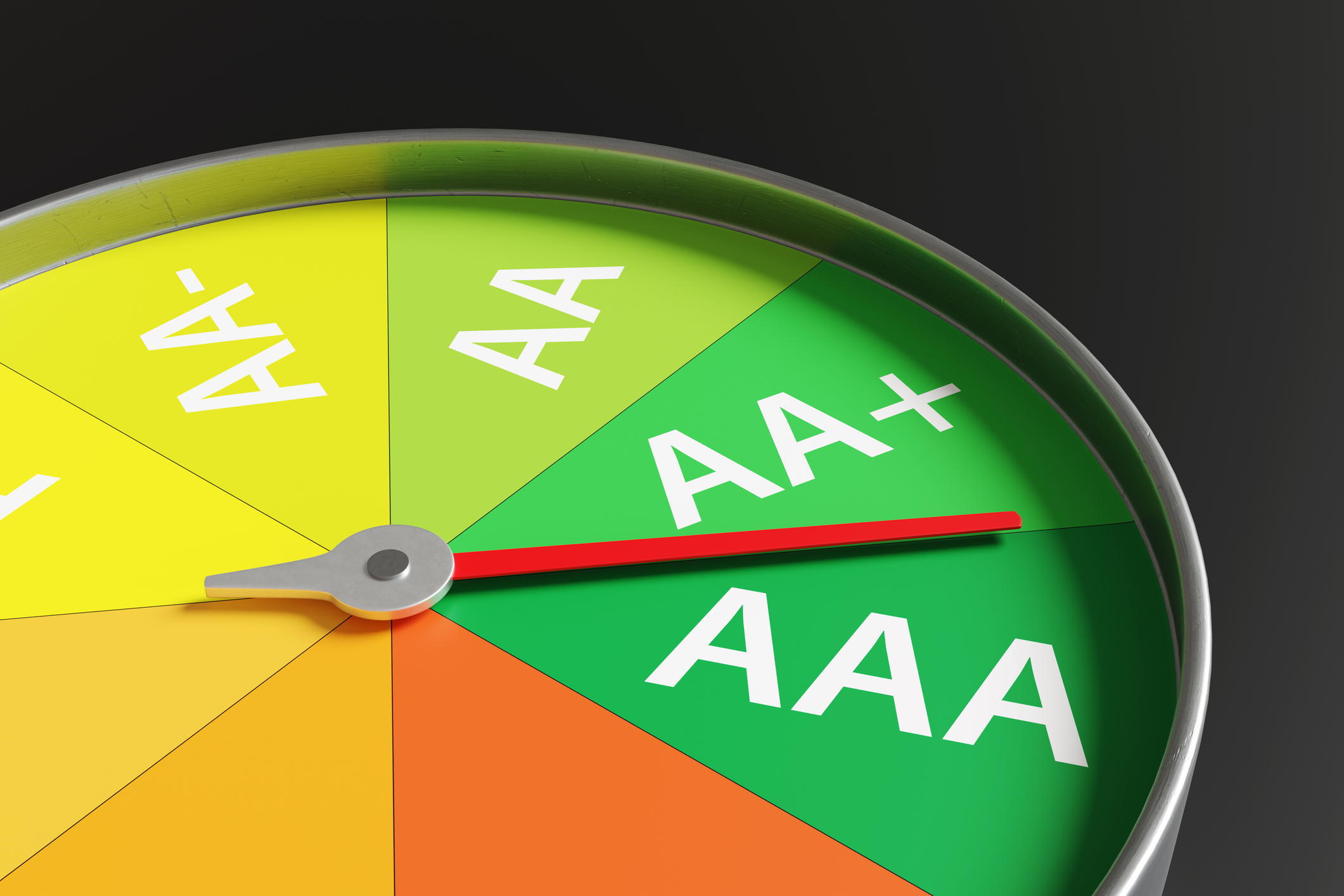Bond Ratings and What They Mean
Bond ratings measure the creditworthiness of your bond issuer. Understanding bond ratings can help you limit risk and maximize your yield.


Bond ratings are an important market factor for every investor to understand. In short, bond ratings can help you decide whether to make an investment.
Knowing what bond ratings mean can help you diversify your portfolio in an efficient way and to manage your overall risk.
At the most basic level, bond ratings indicate the likelihood of repayment in accordance with the terms of the issuance. But competing bond rating systems can make it more complicated to understand what ratings mean.
From just $107.88 $24.99 for Kiplinger Personal Finance
Become a smarter, better informed investor. Subscribe from just $107.88 $24.99, plus get up to 4 Special Issues

Sign up for Kiplinger’s Free Newsletters
Profit and prosper with the best of expert advice on investing, taxes, retirement, personal finance and more - straight to your e-mail.
Profit and prosper with the best of expert advice - straight to your e-mail.
Let's dig into the agencies and their respective bond ratings to better understand how to use them to evaluate the risks of your potential fixed-income investments.
The relationship between risk and yield
When you buy bonds, it's tempting to look for the highest available yields. But yield figures can be misleading.
You also need to consider the quality of the bond itself. If there's any doubt about the ability of the bond issuer to pay on time, high yield could be poor compensation for the risk.
In general, small investors should stick with high-quality bonds.
At the top of the safety scale are U.S. government bonds. The government is the only borrower in the market that can print money to pay its debts, if necessary.
Treasury bonds, notes and bills are backed by the full faith and credit of the government. They top the list of the safest financial assets you can buy.
Securities issued by U.S. agencies, corporations and local governmental units have a higher risk profile.
Here, you'll find bonds ranging in quality from those that are nearly as solid as U.S. government issues to those close to or already in default.
How do you find high-quality bonds? Reliable and respected ratings agencies gather all the data and issue bond ratings.
Financial professionals all over the world use bond ratings, which greatly impact bond prices and bond yields.
What are the main bond ratings agencies?
Most widely traded bonds are rated by at least one of the major agencies in the field — Moody's Investors Service and Standard & Poor's Corp.
Fitch also rates bond issues for default risk.
S&P Investment Grade Ratings: AAA, AA, A, BBB, BB, B
Moody's Investment Grade Ratings: Aaa, Aa, A, Baa
S&P Speculative Grade Ratings: BB, B, CCC, CC, D
Moody's Speculative Grade Ratings: Ba, B, Caa, Ca, C
Standard & Poor's AA, A, BBB, BB and B ratings are sometimes supplemented with a plus or a minus sign to raise or lower a bond's position within the group.
Moody's applies numerical modifiers in each generic rating classification from Aa through Caa.
The modifier 1 indicates that the obligation ranks in the higher end of its rating; a 2 indicates a midrange rank; and a 3 indicates a ranking in the lower end of the generic rating category.
The investment grades include bonds ordinarily bought by individuals and institutional investors seeking a steady stream of income and safety.
BBB/Baa are the lowest ratings that qualify for commercial bank investments.
It's a borderline group for which, in Standard & Poor's words, adverse economic conditions or changing circumstances are more likely to lead to a weakened capacity to pay interest and repay principal than for bonds in higher-rated categories.
Dipping below BBB/Baa takes you into speculative territory. Because of their higher risk of default, such bonds must pay higher yields.
"High yield" is the marketing name for what most people call junk bonds.
Moody's and Standard & Poor's don't always agree on a bond's rank. It's not unusual for them to rate an issue one grade apart.
If you see this happening, take it as a sign of uncertainty about the company that issued the bond.
How bond ratings affect price
Normally, you pay a higher price, and receive a lower yield, with each notch you move up the quality scale.
A triple-A bond usually costs more than a double-A with comparable characteristics, a double-A costs more than an A, and so on.
Few investment-grade issues have defaulted, but the few instances of default are enough to reinforce the attractiveness of the highest ratings.
The rating agencies try to track the financial condition of issuers and update their ratings if necessary.
Many issues are either upgraded or downgraded each year, so check current ratings when buying bonds that have been on the market for some time.
The bottom line on bond ratings
Bonds are often considered a safe way to park money, collect interest and cash in at maturity. That's true of investment-grade bonds, but not all bonds get that coveted rating.
Ratings agencies do a thorough analysis and grade bonds according to their risk, including likelihood of default.
Use their bond ratings as a guidepost and don't take on more risk that you can bear for the promise of a large return that might never materialize.
Related Content
Profit and prosper with the best of Kiplinger's advice on investing, taxes, retirement, personal finance and much more. Delivered daily. Enter your email in the box and click Sign Me Up.

Donna joined Kiplinger as a personal finance writer in 2023. She spent more than a decade as the contributing editor of J.K.Lasser's Your Income Tax Guide and edited state specific legal treatises at ALM Media. She has shared her expertise as a guest on Bloomberg, CNN, Fox, NPR, CNBC and many other media outlets around the nation. She is a graduate of Brooklyn Law School and the University at Buffalo.
-
 I Drive and Collect Classic Cars: Here’s How I Got Started
I Drive and Collect Classic Cars: Here’s How I Got StartedAre classic cars a hobby or an investment strategy — or both? Either way, the vintage car scene is much cooler and more affordable than you think.
-
 My First $1 Million: Retired Middle School Teacher, 68
My First $1 Million: Retired Middle School Teacher, 68Ever wonder how someone who's made a million dollars or more did it? Kiplinger's My First $1 Million series uncovers the answers.
-
 The $183,000 RMD Shock: Why Roth Conversions Can Be Risky
The $183,000 RMD Shock: Why Roth Conversions Can Be RiskyConverting retirement funds to a Roth is a smart strategy for many, but the older you are, the less time you have to recover the tax bite from the conversion.
-
 What to Expect from the Global Economy in 2026
What to Expect from the Global Economy in 2026The Kiplinger Letter Economic growth across the globe will be highly uneven, with some major economies accelerating while others hit the brakes.
-
 Shoppers Hit the Brakes on EV Purchases After Tax Credits Expire
Shoppers Hit the Brakes on EV Purchases After Tax Credits ExpireThe Letter Electric cars are here to stay, but they'll have to compete harder to get shoppers interested without the federal tax credit.
-
 The Economy on a Knife's Edge
The Economy on a Knife's EdgeThe Letter GDP is growing, but employers have all but stopped hiring as they watch how the trade war plays out.
-
 Banks Are Sounding the Alarm About Stablecoins
Banks Are Sounding the Alarm About StablecoinsThe Kiplinger Letter The banking industry says stablecoins could have a negative impact on lending.
-
 Japan Enters a New Era of Risk and Reform
Japan Enters a New Era of Risk and ReformThe Kiplinger Letter Japan has entered a pivotal moment in its economic history, undertaking ambitious policy and structural reforms to escape from decades of stagnation.
-
 After Years of Stagnant Growth, Hope Emerges for EU Economy
After Years of Stagnant Growth, Hope Emerges for EU EconomyThe Kiplinger Letter Can a German fiscal push outweigh French political peril?
-
 The Most Tax-Friendly States for Investing in 2025 (Hint: There Are Two)
The Most Tax-Friendly States for Investing in 2025 (Hint: There Are Two)State Taxes Living in one of these places could lower your 2025 investment taxes — especially if you invest in real estate.
-
 Trump's Economic Intervention
Trump's Economic InterventionThe Kiplinger Letter What to Make of Washington's Increasingly Hands-On Approach to Big Business